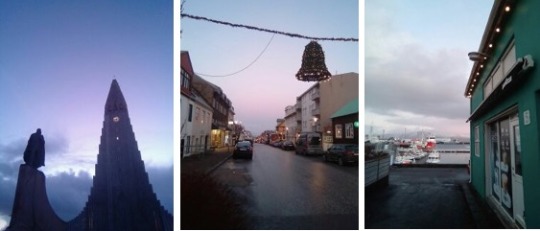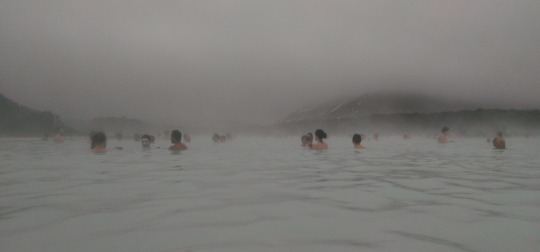#sagamuseum
Text
Iceland’s Blue Oasis
No Iceland travel blog would be complete without at least a quick dive into the country’s capital city of Reykjavik, or the nearby iconic Blue Lagoon.
Located in Southwestern Iceland, about a 50-minute drive from Keflavik International Airport, Reykjavik is situated on the northern side of the Reykjanes peninsula – the only place in the world where the Mid-Atlantic ridge comes ashore above sea level. This small capital city of about 120,000 people is often the first stop for most travelers upon arrival in Iceland, whether visiting for a few quick days or embarking upon a longer journey. Its bustling international tourism scene and recent emergence as a hotspot for adventure-filled layovers have led to the availability of a wide variety of activities to meet diverse interests. Though relatively small in terms of international cities, Reykjavik more than makes up for its diminutive population with an abundance of personality and charm that is uniquely Icelandic.
Visiting Reykjavik
Lodging: Reykjavik offers perhaps the most varied lodging opportunities in Iceland, from low-cost hostels to large-group rentals to high-end luxury hotels or flats. For those seeking locations close to restaurants, shopping, and sightseeing, lodging within ‘the 101’ – a downtown/city-center neighborhood along the zone from the Reykjavik Harbor to the streets surrounding landmark Hallgrimskirkja church – will prove central to most points of interest. Partygoing groups interested in being near the lively bar scene are wise to stay near Laugavegur and Hverfisgata streets in this neighborhood. Those seeking calmer or quieter stays can stray just a few blocks away from the main streets to find more tranquil lodging, or can explore the accommodations with neighboring districts Vesturbaer (to the west) and Hlidar (to the east).
Getting Around: The city is quite walkable from most accommodations in the city center, though visitors who seek lower-cost housing options in less central neighborhoods or suburbs may require automotive transportation to access its main sights. Note that many rentals within city center do not offer reserved parking spaces for vehicles; finding parking spaces isn’t so much of a problem in off-season months but can become difficult during peak summer season. Reykjavik also has a well-developed public bus system with regular service connecting all the city’s neighborhoods and destinations, and the Reykjavik City Card offers users 24, 36, or 72 hours of unlimited travel on city buses (and also includes admission to several major attractions and discounts at a handful of shops and restaurants). The service’s website (www.straeto.is/en) also offers a useful trip planner tool to help make bus travel easier.
Sightseeing & Activities: Reykjavik is full of cultural history, highlighted by its many museums and public works of art scattered throughout the city (of note are some unique museums, such as the Volcano Center, the Saga Museum, and the Icelandic Phallogical Museum). Interesting architectural designs include the noteworthy Opera House with its nighttime light shows and the famed Hallgrimskirkja Church, guarded at its front by a statue of Icelandic explorer, Leif Erickson. Reykjavik’s traditionally bright-colored wooden homes add a unique personality to its picturesque streetscapes, and Icelanders’ quirky design aesthetics make window-gazing along the city’s main shopping streets a delight; be sure to check out the main shopping strip on Laugavegur Street.

Reykjavik’s burgeoning culinary scene offers something for everyone, from the famed Icelandic hot dogs to fresher-than-fresh seafood to delicious cuisines from around the world. As mentioned in previous posts, sit-down meals can be quite costly, but the quality of the food makes it well worth the splurge and can be offset by heading to a grocery store and cooking other meals in your accommodation. For more adventurous eaters, several restaurants also offer the opportunity to sample traditional Icelandic fares such as brennivin (a clear, distilled, unsweetened schnapps that is Iceland’s signature liquor), whale steaks, fish stews, and – for the very brave – hakarl (fermented “rotten shark” cured using a centuries-old process, with a strong ammonia smell and potent fishy taste).

Reykjavik is also home base for a wide variety of guided adventures, including excursions by sea (whale-watching and northern lights tours are among the most popular, though hours may be limited in winter months), day trips to destinations such as the Golden Circle, Jokulsarlon Glacier Lagoon, or Snaefellsnes Peninsula, and other adventurous activities such as exploring ice caves, highland snowmobiling, cliffside bird-watching, off-roading in SuperJeeps, and riding Icelandic horses.
Before your visit, be sure to check the city’s event calendar: https://visitreykjavik.is/events. Iceland is home to a variety of year-round activities and events ranging from opera performances to holiday festivals to music and sporting events and everything in between. Of note, are Reykjavik’s beautiful holiday lights and decorations around Christmas time, including an ice-skating rink and holiday market at city center.

The Blue Lagoon
Perhaps the most iconic destination in Iceland, the Blue Lagoon – made famous by visits from A-list celebrities and touted by Instagrammers galore – is by far the country’s most visited tourist stop.

Located about 45 minutes by car from Reykjavik, and just a short 20 minutes from Keflavik airport, the Blue Lagoon’s steaming, bright blue geothermal pools beckon visitors from around the world to stop by for a soak. The Blue Lagoon is a man-made landmark, with the water’s heat sourced from a local geothermal plant that captures heat from the earth and turns it into energy. The Lagoon’s silica-rich waters and trademark mineral mud mask available by the scoopful throughout the Blue Lagoon soften the skin of bathers (though those with long locks, beware – the minerals in the water wreak havoc on hair, so be sure to apply the provided conditioner before entering the water to prevent mineral build-ups that will make hair unmanageable for weeks afterwards).
Reservations to the Blue Lagoon are recommended for all visitors, especially during weekends, holidays, and peak tourism season, and also for those seeking spa treatments (such as massages or facials during their visit). Upon arrival at the Blue Lagoon, visitors check in and receive a robe, towel, and flip flops, and then proceed to shower facilities with lockers to rinse off, change into swimsuits, and lock up valuables before entering the relaxing warm waters of the lagoon. Plan to arrive as early in the day as possible, as it tends to get busier later in the day as tour groups arrive, and the relatively high entry price warrants spending as much time as possible soaking in those cozy waters. In addition to spa services, the Blue Lagoon offers a full-service restaurant (reservations recommended), a more casual café with lighter dining fare, and a growing set of luxury lodging options.
Some honest thoughts: After visiting the Blue Lagoon on the last day of our trip, my travel companions and I all agreed that we had enjoyed our visit to the smaller – yet far less-crowded and more relaxing – Myvatn Nature Baths near Akureyri much more than our day at the Blue Lagoon. Not that I’ll ever turn down a soak in warm, therapeutic waters; but, after our week of travels in less populated parts of the country, the Blue Lagoon felt hectic and overly commercialized. The locker rooms were crowded, it was difficult to find a place to leave our towels, and the pools (especially the one with a bar in it) certainly had more of a party vibe than a relax-in-peace vibe. To be fair, this may have been because our visit was during the Easter holidays. The Blue Lagoon experience may be entirely different when there are fewer visitors (i.e. during the week or in the off season), and it is certainly worth a stop to try it for yourself.
In all, I would say it was an enjoyable experience – just be warned that it may not be as tranquil as the Instagram pictures make it seem. And given the plethora of smaller hot pots, geothermal bath facilities, and hidden hot springs scattered throughout Iceland, it’s definitely worth exploring beyond the Blue Lagoon for your moment of Icelandic tranquility.

Wrapping Up
And with that, we wrap up our Iceland series! We hope you’ve enjoyed this tour through Iceland over the past several weeks through the eyes of our guest blogger Carolyn. There’s no doubt this destination full of rugged natural beauty and rich in cultural history holds something for adventurers of all kinds, and we hope our tips have helped inspire your travels and feed your wanderlust.
Stay tuned next week as we begin exploring our newest destination… any guesses where?!?
#soraya#sorayaadventures#traveler#traveller#curioustraveler#lovetravel#offthebeatenpath#explorer#travels#iceland#icelandicadventure#northern europe#blue lagoon iceland#blue lagoon spa#reykjavik#northern lights#whalewatching#cultural history#sagamuseum#internationaltravel#spatravel
0 notes
Photo

Ready for battle. #sagamuseum (at Sögusafnið / Saga Museum)
0 notes
Photo

Horses everywhere herr in Front of the Sagamuseum in Reykjavik
0 notes
Photo

#sagamuseum #reykjavik #viking (presso Viking Saga Museum)
0 notes
Photo

Говорят Эдда выглядела как то так. #sagamuseum #reykjavik #iceland
0 notes